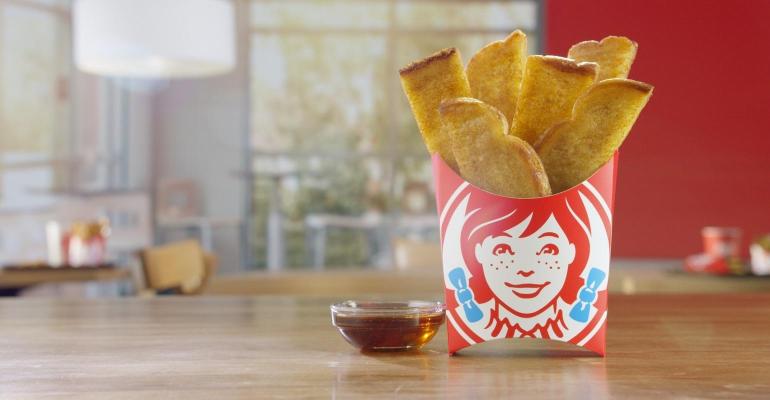Wendy’s breakfast menu officially turned 3 earlier this month. Well, its latest breakfast menu, that is. The company has offered breakfast before, several times.
Its first foray into the daypart was in 1985, but the chain pulled back after just nine months. It tried again in 2007 and, yet again in 2012. The last go-round was also short-lived because Wendy’s wasn’t meeting its profitability targets.
So, how are things this time around? On the surface, they appear to be much, much better, and at least hitting the low-end of its targets. The company initially pumped in a $20 million investment for labor and brand awareness support to ensure this launch would stick. The company also took a different approach than its previous iterations, keeping things simple and leveraging its iconic products, like with the Breakfast Baconator and the Frosty-ccino. In a little over a year, and despite the pandemic taking many morning commuters off the road, Wendy’s breakfast was mixing above 7.5% of sales. By Q4 2021, breakfast reached 8.5% of the company’s sales mix.
CEO Todd Penegor expressed confidence at that time that the sales mix would get to 10% by the end of 2022 as mobility and innovation returned. Morning mobility made a strong comeback, and Wendy’s embraced more innovation, launching products like the hot honey butter chicken biscuit. Nearly one full quarter into 2023, however, the company is no longer reporting the daypart’s mix, and its $20 million investment is coming to an end. That doesn’t mean things are bad, however. It certainly doesn’t mean the fourth time hasn’t been a charm so far.
“We transitioned away from disclosing breakfast sales mix targets as we measure the success of the breakfast business by sales volumes,” a company spokesperson said. That means a new goal of reaching $3,000 to $3,500 in breakfast sales per restaurant per week.
In Q4, Wendy’s surpassed that $3,000 target, which added a profitable sales layer to the business, executives said. BTIG analyst Peter Saleh believes the daypart is sufficiently filling a “big hole” in Wendy’s business and the approach this time around better positions the brand in the morning daypart.
“The way they had done it in the past was more market-by-market. They really hadn’t done it nationally all at once and that gave competitors, predominantly McDonald’s, the chance to come into their markets and coupon like crazy,” Saleh said. “The national strategy they have now is better.”
Of course, the timing of Wendy’s was terrible, going live mere weeks before Covid-19 shutdowns proliferated throughout the country. But, the train kept rolling and now the targets have been met, which means Wendy’s could very well be considered a formidable – and resilient – breakfast player.
“I think this was a missing component for Wendy’s and they went after it hard and invested in it hard and it seems like it’s at least remotely profitable for its franchisees,” Saleh said.
That said, breakfast is an intense category. Competitors, including Taco Bell (which added breakfast in 2014) and McDonald’s, have both reported strong performances in their morning dayparts in recent quarters. So, Wendy’s, especially as its investment dissipates, will have to keep finding ways to drive frequency and awareness against those chains with much bigger footprints.
“Going after the beverage category is a way to get there. One of the concerns about launching breakfast is it’s the most habitual daypart. You’ve got to get people to switch from what they’re used to, which is really hard to do, especially if you’re not promoting coffee,” Saleh said. “Customers will come in for coffee and, at the very least, get that coffee which is high margin, and the best case get a coffee and sandwich and drive real incremental sales. I’m surprised they didn’t focus on coffee out of the gate.”
Sure, Wendy’s has its vanilla and chocolate Frosty-ccinos, as well as a cold brew and regular and decaffeinated coffees, but those offerings haven’t been front and center like its “Redhead Roaster” of breakfast’s past. This is likely to change. For instance, during the company’s most recent earnings call, Penegor said, “We've talked in the past around beverage credibility and doing some things around coffee, and you'll see some things coming that way during the course of this summer. There’s still a lot of opportunities for us to continue to drive not just awareness, but repeat to ingrain that morning routine and we’ll continue to work on that.”
In the meantime, Wendy’s breakfast seems to be going to plan. Otherwise, the company would perhaps be infusing more dollars into the daypart.
“That says to me they’re at least comfortable with the level of sales and profit and I guess they don’t feel the need to make additional investments to keep franchisees on board with breakfast,” he said. “They’re at about $3,000 a week in sales, or about $156,000 of revenue per unit. That revenue is coming from somewhere and it’s probably at the expense of some other brands. They clearly gained share in breakfast because they went from zero to $3,000 a week.”
Contact Alicia Kelso at [email protected]





